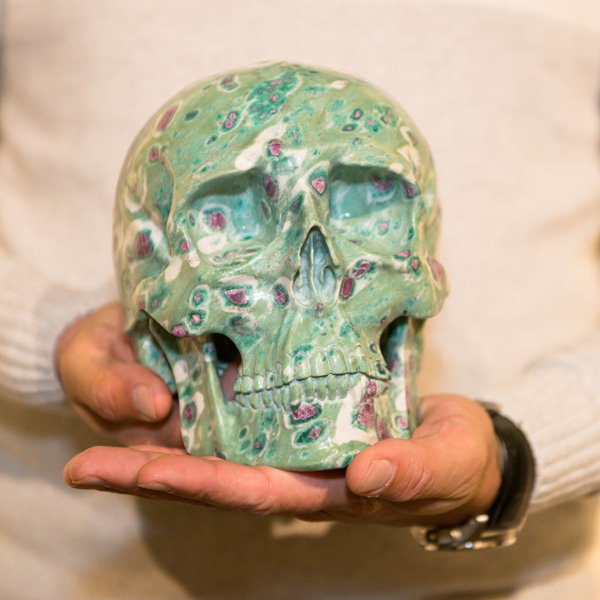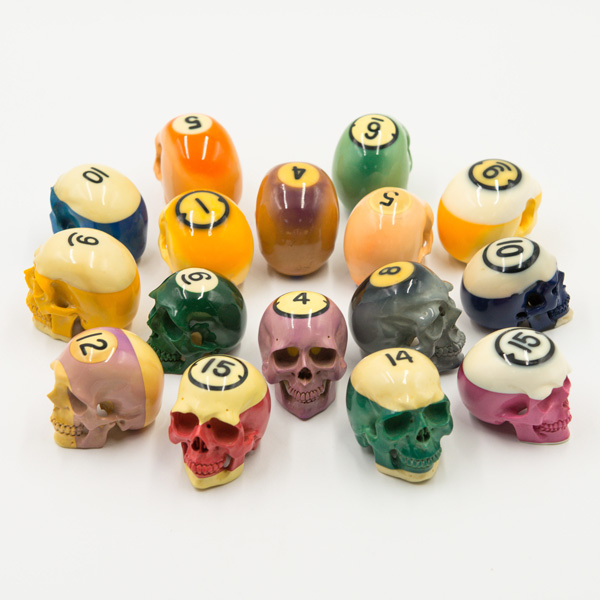Indonesia-based, American-born artist, sculptor, and paleo-naturalist Lee Downey has been designing spatially-dynamic and compelling works of decorative sculpture for more than four decades.
Lee Downey is especially known for his intricately detailed works based on natural subjects, particularly his life-like and life-sized skull carvings, made from materials as varied as 4-billion-year-old meteorite iron, dinosaur bone, and fossilized Siberian Jet.
EXPLORE THE COLLECTION NOW
Lee Downey has demonstrated a firm artistic footing in several areas of craftsmanship, from fossil sculpture to the wearable art of jewelry. From his origins as a silversmith in Arizona (USA), Lee has had a lifelong passion for working with natural mediums, from breathtaking pieces in turquoise and rock to exquisite minerals, gems, and fossilized dinosaur bones.
Since 1984, Lee has based his home and studio in the village of Tampaksiring, Bali (Indonesia), an ancient place of history and spirituality, and the center of an important archaeological site. Tampaksiring was a major kingdom prior to European colonialization in the 19th century. From the holy springs of Tirta Empul, to the 11th-century temple and funerary complex of Gunung Kawi, the ancient, sacred, and natural mingle freely in the shadow of this still-mysterious place that remains largely unknown to the modern world.
Years of traveling through Asia and exposure to its secrets, and his work with native carvers and metalworkers has informed his design aesthetic, which reflects a fusion of cultures and styles, and has helped introduce their ancient techniques, styles, and craftsmanship to a worldwide audience.
Among these techniques is Mokume-gane, a Japanese metalworking method that produces a mixed-metal surface with distinctive patterns that resemble natural wood grain; the technique was originally developed to decorate swords.
Lee and the craftsmen-carvers of Bali create their breathtaking work using materials chosen to endure the test of time and to please the eye.
Siberian Jet, a fossil gemstone millions of years old, has been used in sculpture since at least 10,000 B.C. It has an organic origin, being derived from high-pressure decomposition of wood millions of years ago. (The phrase “jet-black,” meaning the darkest black possible, comes from its name.)
One of the rarest of gemstones, Agatized Dinosaur Bone, or Dinosaur Gembone, is an extremely rare form of fossil that is found only within the Morrison Formation on the Colorado Plateau, a geologic area approximately 150 million years old.
Tranquillityite is a mineral once found only on the moon. It was named after the Mare Tranquillitatis (Sea of Tranquility), the place from which the rock samples were brought back during the 1969 Apollo 11 Lunar mission. It is possibly one of the rarest minerals on Earth. Until its discovery in Australia in 2011, Tranquillityite was the last mineral brought from the Moon which was thought to be unique, with no Earthly counterpart. Using uranium-lead dating techniques, the estimated age of Tranquillityite is 3.7 billion years.
Ruby-Zoisite from Tanzania is one of the world’s most colorful ornamental gemstones, and includes several varieties, including the deep green massive form associated with contrasting Ruby, which Lee uses to carve thought-provoking pieces with unique patterns.
Tourmaline is a crystalline semi-precious stone that comes in a wide variety of colors. Arresting to see, brightly colored tourmalines were used by chemists in the 19th century to polarize light by shining rays onto a cut and polished surface of the gem.
In ancient societies, skulls represented life, the embodiment of consciousness, and the honoring of humanity in the flesh. Lee has a deep appreciation for the human skull, a motif that finds its way into some of his most sought-after works.
Lee’s fascination with skeletons and skulls can be seen in his figurative work, which is often reminiscent of toys and games. Among Lee’s most popular creations are hand-carved Billiard Ball Skulls, each crafted with an expression that displays a unique personality. Sold individually or in complete sets, they have drawn attention and praise internationally. In this spirit, Lee was commissioned by the studio of British artist Damien Hirst to carve a set of balls for Snooker (a Billiards-like cue game).
“The carved balls started out as a fun way to use up some material hanging around the [studio],” Lee says. “And they took off right away.”Frogs likewise inform the shape and design of some of Lee’s most interesting sculptures. The frog is a popular Asian good luck meme, and there are many frog lovers and collectors around the world.
Lee’s vision, influence and works, containing a lively realism and rhythm combined with time-honored techniques, are shaping the landscape of natural art and sculpture.
EXPLORE THE COLLECTION NOW












